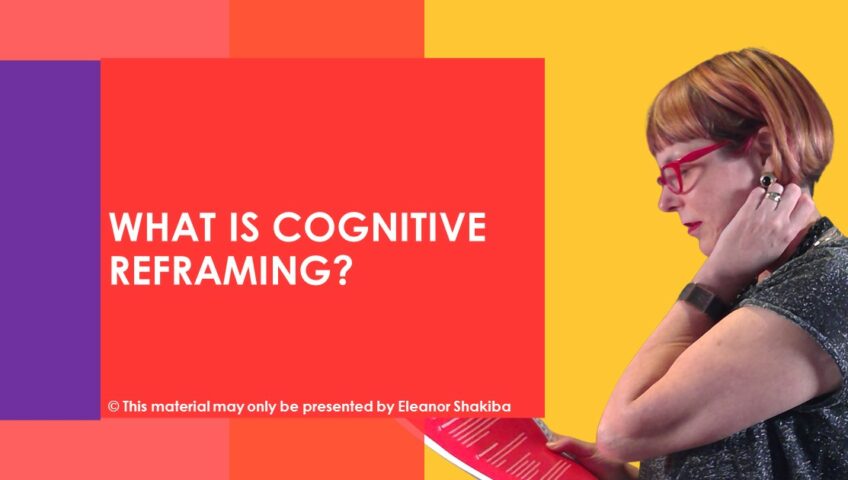When dealing with a stressful situation, it’s easy to assume the worst. This is particularly true if you’ve taken on patterns of ‘learned helplessness’ or pessimistic thinking. However, you can extract yourself from worry loops by shifting your thinking habits. Instead of focusing on the negative, consider changing the way that you look at the problem. This is a technique you’ll learn in any resilience training or positive psychology workshop.
So, what is cognitive reframing? It’s one of the most-used stress relief strategies. Cognitive reframing involves changing the way that you look at something. By reframing your perspective of a situation, you minimise the perceived stress, allowing you to focus on overcoming your challenge. Here’s a closer look at how it works.
The use of cognitive reframing as a positive psychology technique comes from the development of cognitive therapy in the 1960s. Aaron Beck is considered the father of cognitive therapy. During his time working with patients who suffered from depression, Beck noticed a common theme among his patients. They often dwelled on negative thoughts and found negativity in everyday situations.
Beck developed a process called ‘cognitive restructuring’, which involves turning a negative thought into a positive thought. Over the years, psychologists have studied the effectiveness of Beck’s technique. Cognitive behavioural therapy (CBT) has become a recommended option for treating everything from eating disorders and depression to mental illness and marital problems.
In recent years, many psychologists have explored how negative thinking promotes stress and exacerbates mood disorders, such as anxiety and depression. This group includes Harry Mills, Natali Reiss and Mark Dombeck. The trio has published work on the impact of stress and how cognitive reframing can help.
The group argues that ignoring the problem promotes decreased cognitive function and an increased risk of anxiety disorders and personality changes. Luckily, anyone can practice cognitive reframing techniques.
The concept behind cognitive reframing revolves around the fact that most people are hard-wired to focus on the negative more than the positive. Cognitive reframing involves replacing negative thoughts with positive ones to alter the way that you think about a situation or problem.
There are many techniques for reframing your perception of things.
Self-monitoring
The first step of cognitive reframing is self-monitoring. You need to learn to recognise negative feelings before you can change them. Recognising negative emotions helps you detect the patterns that tend to trigger your anxieties and stress.
For example, if you tend to feel anxious about public speaking, you may notice that the anxiety increases in specific situations. Finding this common thread makes it easier to catch negative thoughts before they get the better of you.
Question your assumptions
Cognitive reframing also typically involves questioning your assumptions. You need to challenge your thoughts to determine if they are illogical or biased. For example, when you have a negative thought, you may ask yourself, “What evidence do I have to prove that this thought is accurate?” Questioning the reasons for your anxiety helps you change the way you deal with the situation.
Analyse the pros and cons
After questioning your assumptions, you may still hold on to negativity. In these situations, you should weigh the pros and cons in a cost-benefit analysis. Determine the advantages and disadvantages of your negative thinking. In most cases, the disadvantages outweigh the advantages.
Introduce alternatives
The next step is to introduce alternative thoughts. Generating positive thoughts helps you challenge your tendency to think negatively and find solutions to your problems.
If you’re tired of letting stress and anxiety overtake your thoughts, it’s time to focus on the positive. Cognitive reframing strategies and resilience training allow you to change your perspective. Consider working with positive psychology trainers to develop new methods for overcoming stressful situations. Contact Eleanor Shakiba to discuss the best cognitive reframing techniques for uplifting your team.
About the author: Eleanor Shakiba
Eleanor is a positive psychology trainer and coach. Her passion is teaching skills for positive thinking, proactive communication and purposeful leadership. Her clients work in academia, education, IT, engineering, finance and health. Eleanor is qualified in Social Anthropology, Positive Psychology, Counselling, Coaching, Adult Education and Neuro Linguistic Programming. She’s the author of the Positive Psychology Toolkit for HR and L&D Practitioners, a free resource for trainers.
